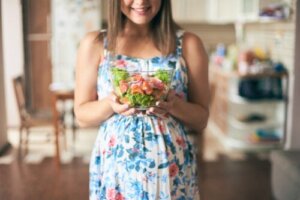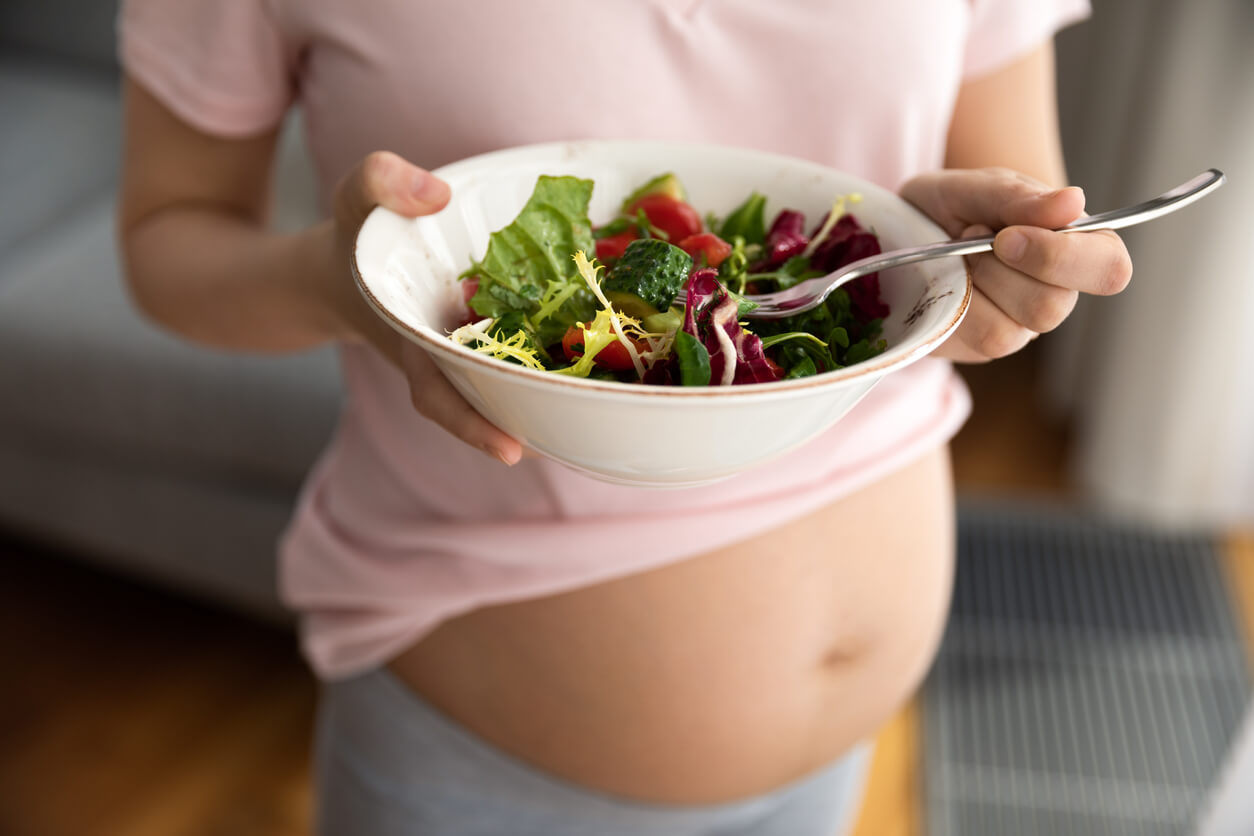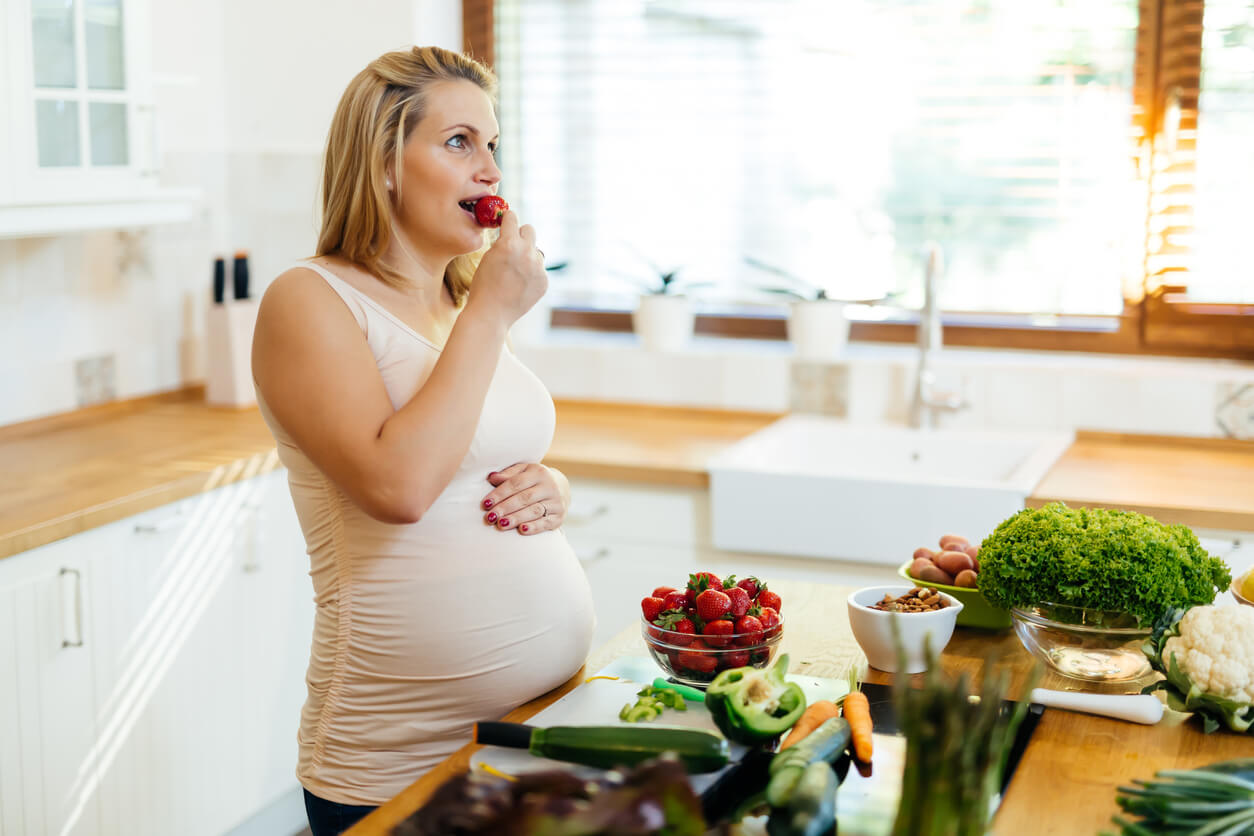Tips to Increase Iron and Calcium Intake in Pregnant Vegans

During pregnancy, all nutritional requirements are increased. This is why it’s important to make sure that the diet is correct for both mother and baby. With a restrictive diet such as a vegan diet, there are some critical nutrients that may be missing. However, with just a few adjustments in the diet, they can be supplied without any problem. For those pregnant vegans, here are some tips to increase iron and calcium intake.
The importance of iron and calcium in pregnant vegans
Iron is a vital mineral for both the mother and the baby. Seventy percent binds to hemoglobin to transport oxygen to cells and participate in cell division, differentiation, and gene expression.
Iron deficiency anemia is common during pregnancy and can cause low birth weight and premature delivery. For this reason, supplements and foods high in iron are recommended during the second and third trimesters. Recommended doses are 27 milligrams daily.
In regard to calcium, 99 percent is stored in the form of bones and teeth. Therefore, it’s an essential mineral for the baby’s bone formation. In addition, it’s also involved in muscle function, nerve signals, and other metabolic functions. For this reason, experts recommend increasing calcium intake by 50%. The final intake will be 1200 to 1300 milligrams daily.
Read also: 6 Keys to a Healthy Vegetarian Pregnancy
Why iron and calcium are affected by veganism
Vegetarian diets are divided into several subgroups according to the foods of animal origin that they exclude. But unlike others, such as ovo-dairy-vegetarians, the vegan diet omits them altogether. However, it includes a wide variety of plant foods.
Both minerals are best absorbed when they come from animal foods, such as red meat, which provides heme iron, which is absorbed by 25 to 30%. On the other hand, non-heme iron, such as that found in green leafy vegetables, is absorbed by 1 to 10%. Dairy products, such as cheeses and yogurt, are those that contain more calcium per serving.
For these reasons, in the diet of pregnant vegans, it’s necessary to apply certain strategies to take better advantage of these 2 important nutrients. In this regard, as referred to in the magazine Nutrients magazine, a well-planned vegan diet can be considered safe during pregnancy. However, it’s important to be aware of the intake of key nutrients.

Tips to increase iron and calcium intake in pregnant vegans
Remember that your obstetrician and nutrition professional will give you professional recommendations on supplements and diet. However, here are some tips:
Increase the consumption of vegetables that contain more iron and calcium
In 2022, the magazine ACS Omega stated that the consumption of foods that are a source of minerals is one of the main factors that determine their status in the body.
Iron
In the case of iron, these are the foods that contain it in greater proportion:
- Legumes: Lentils, black beans, and chickpeas
- Pasta and textured soybeans: Tofu
- Green leaves: Chard and spinach
- Nuts: Walnuts, hazelnuts, pistachios, and almonds, among others
- Dried fruits: Raisins and dried apricots
- Cereals fortified with iron: Oats, quinoa, and pasta
Calcium
Root vegetables are involved in the strict regulation of the amount of calcium absorbed by the plant. In the roots, calcium is stored and then transported to the shoots and, finally, to the leaves, where most of it is concentrated. Some of the foods that contain it are the following:
- Leaves: Lale, spinach, Chinese mustard leaves, and bok choy.
- Roots: Sweet potatoes, tubers, and African millet.
In addition, another cereal known as teff is also found in this food group, as revealed in the journal Frontiers in Plant Science, as well as sesame seeds and tofu. However, all these vegetables are dominated by oxalates and phytic acid, which are considered anti-nutrients because they prevent the absorption of these minerals.
Increase the bioavailability of iron and calcium
The National Library of Medicine explains that iron absorption depends on the state in which it’s found. Non-heme iron, which predominates in vegetables, is in an oxidized or ferric form, which isn’t well absorbed. Therefore, in order to improve this situation, it has to dissolve in the stomach and bind to certain food components that can increase its bioavailability.
Absorption enhancers include vitamin C. A review explains that vitamin C also transforms the non-absorbable ferric form of iron into the ferrous form so that it can be transported by cells in the intestine. In addition, it can counteract the presence of components that impede iron absorption, such as oxalates, phytic acid, polyphenols, and insoluble dietary fiber.
Read also: Benefits of Calcium, Iron and Zinc During Pregnancy

Reduce iron and calcium inhibitors
Some processing techniques can increase mineral absorption by reducing the amount of inhibitors in the food. The journal Frontiers in Plant Science, 2021, explains that methods to improve bioavailability are as follows:
- Use of high temperatures: Cooking vegetables and legumes can reduce levels of phytate, a phosphorus storage molecule in vegetables, which traps minerals such as calcium and iron.
- Soaking: Some vegetables, such as legumes, when soaked for at least 8 hours prior to cooking, reduce tannin and phytate levels.
- Germination of grains: The process of obtaining sprouts from legumes and cereals activates an internal seed enzyme called phytase, which destroys phytates and releases trapped minerals.
- Fermentation of grains or vegetables, such as sour cabbage, reduces phytate levels.
Eliminate interactions with other food components
Some food components can’t be mixed with each other because one mineral or another is inhibited. For example, it’s important not to consume supplements or vegetables that are very rich in calcium together with iron sources. The Journal of Nutrition comments on this condition and how it’s improved with the addition of vitamin C.
For its part, it’s best not to mix calcium-rich products with tea, coffee, or chocolate. This is because they contain oxalate salts that reduce the absorption of the mineral. In addition, high sodium intake can also increase the excretion of calcium in the urine.
The guidance of professionals is key
Vegan pregnant women should incorporate into their diet those vegetables richest in iron and calcium, as long as care is taken to enhance the absorption of these minerals. Including foods that are a source of vitamin C or using supplements is one way to help iron absorption. Other ways include soaking and cooking grains by opting for sprouts or sprouted legumes and eliminating tea, coffee, or chocolate from the diet.
Remember that it’s your obstetrician and nutritionist who will give you all the guidance you need to make your vegan diet as balanced and healthy as possible.
During pregnancy, all nutritional requirements are increased. This is why it’s important to make sure that the diet is correct for both mother and baby. With a restrictive diet such as a vegan diet, there are some critical nutrients that may be missing. However, with just a few adjustments in the diet, they can be supplied without any problem. For those pregnant vegans, here are some tips to increase iron and calcium intake.
The importance of iron and calcium in pregnant vegans
Iron is a vital mineral for both the mother and the baby. Seventy percent binds to hemoglobin to transport oxygen to cells and participate in cell division, differentiation, and gene expression.
Iron deficiency anemia is common during pregnancy and can cause low birth weight and premature delivery. For this reason, supplements and foods high in iron are recommended during the second and third trimesters. Recommended doses are 27 milligrams daily.
In regard to calcium, 99 percent is stored in the form of bones and teeth. Therefore, it’s an essential mineral for the baby’s bone formation. In addition, it’s also involved in muscle function, nerve signals, and other metabolic functions. For this reason, experts recommend increasing calcium intake by 50%. The final intake will be 1200 to 1300 milligrams daily.
Read also: 6 Keys to a Healthy Vegetarian Pregnancy
Why iron and calcium are affected by veganism
Vegetarian diets are divided into several subgroups according to the foods of animal origin that they exclude. But unlike others, such as ovo-dairy-vegetarians, the vegan diet omits them altogether. However, it includes a wide variety of plant foods.
Both minerals are best absorbed when they come from animal foods, such as red meat, which provides heme iron, which is absorbed by 25 to 30%. On the other hand, non-heme iron, such as that found in green leafy vegetables, is absorbed by 1 to 10%. Dairy products, such as cheeses and yogurt, are those that contain more calcium per serving.
For these reasons, in the diet of pregnant vegans, it’s necessary to apply certain strategies to take better advantage of these 2 important nutrients. In this regard, as referred to in the magazine Nutrients magazine, a well-planned vegan diet can be considered safe during pregnancy. However, it’s important to be aware of the intake of key nutrients.

Tips to increase iron and calcium intake in pregnant vegans
Remember that your obstetrician and nutrition professional will give you professional recommendations on supplements and diet. However, here are some tips:
Increase the consumption of vegetables that contain more iron and calcium
In 2022, the magazine ACS Omega stated that the consumption of foods that are a source of minerals is one of the main factors that determine their status in the body.
Iron
In the case of iron, these are the foods that contain it in greater proportion:
- Legumes: Lentils, black beans, and chickpeas
- Pasta and textured soybeans: Tofu
- Green leaves: Chard and spinach
- Nuts: Walnuts, hazelnuts, pistachios, and almonds, among others
- Dried fruits: Raisins and dried apricots
- Cereals fortified with iron: Oats, quinoa, and pasta
Calcium
Root vegetables are involved in the strict regulation of the amount of calcium absorbed by the plant. In the roots, calcium is stored and then transported to the shoots and, finally, to the leaves, where most of it is concentrated. Some of the foods that contain it are the following:
- Leaves: Lale, spinach, Chinese mustard leaves, and bok choy.
- Roots: Sweet potatoes, tubers, and African millet.
In addition, another cereal known as teff is also found in this food group, as revealed in the journal Frontiers in Plant Science, as well as sesame seeds and tofu. However, all these vegetables are dominated by oxalates and phytic acid, which are considered anti-nutrients because they prevent the absorption of these minerals.
Increase the bioavailability of iron and calcium
The National Library of Medicine explains that iron absorption depends on the state in which it’s found. Non-heme iron, which predominates in vegetables, is in an oxidized or ferric form, which isn’t well absorbed. Therefore, in order to improve this situation, it has to dissolve in the stomach and bind to certain food components that can increase its bioavailability.
Absorption enhancers include vitamin C. A review explains that vitamin C also transforms the non-absorbable ferric form of iron into the ferrous form so that it can be transported by cells in the intestine. In addition, it can counteract the presence of components that impede iron absorption, such as oxalates, phytic acid, polyphenols, and insoluble dietary fiber.
Read also: Benefits of Calcium, Iron and Zinc During Pregnancy

Reduce iron and calcium inhibitors
Some processing techniques can increase mineral absorption by reducing the amount of inhibitors in the food. The journal Frontiers in Plant Science, 2021, explains that methods to improve bioavailability are as follows:
- Use of high temperatures: Cooking vegetables and legumes can reduce levels of phytate, a phosphorus storage molecule in vegetables, which traps minerals such as calcium and iron.
- Soaking: Some vegetables, such as legumes, when soaked for at least 8 hours prior to cooking, reduce tannin and phytate levels.
- Germination of grains: The process of obtaining sprouts from legumes and cereals activates an internal seed enzyme called phytase, which destroys phytates and releases trapped minerals.
- Fermentation of grains or vegetables, such as sour cabbage, reduces phytate levels.
Eliminate interactions with other food components
Some food components can’t be mixed with each other because one mineral or another is inhibited. For example, it’s important not to consume supplements or vegetables that are very rich in calcium together with iron sources. The Journal of Nutrition comments on this condition and how it’s improved with the addition of vitamin C.
For its part, it’s best not to mix calcium-rich products with tea, coffee, or chocolate. This is because they contain oxalate salts that reduce the absorption of the mineral. In addition, high sodium intake can also increase the excretion of calcium in the urine.
The guidance of professionals is key
Vegan pregnant women should incorporate into their diet those vegetables richest in iron and calcium, as long as care is taken to enhance the absorption of these minerals. Including foods that are a source of vitamin C or using supplements is one way to help iron absorption. Other ways include soaking and cooking grains by opting for sprouts or sprouted legumes and eliminating tea, coffee, or chocolate from the diet.
Remember that it’s your obstetrician and nutritionist who will give you all the guidance you need to make your vegan diet as balanced and healthy as possible.
All cited sources were thoroughly reviewed by our team to ensure their quality, reliability, currency, and validity. The bibliography of this article was considered reliable and of academic or scientific accuracy.
- Abratt, V. R., & Reid, S. J. (2010). Oxalate-degrading bacteria of the human gut as probiotics in the management of kidney stone disease. Advances in applied microbiology, 72, 63–87. https://doi.org/10.1016/S0065-2164(10)72003-7
- Agnoli, C., Baroni, L., Bertini, I., Ciappellano, S., Fabbri, A., Papa, M., Pellegrini, N., Sbarbati, R., Scarino, M. L., Siani, V., & Sieri, S. (2017). Position paper on vegetarian diets from the working group of the Italian Society of Human Nutrition. Nutrition, metabolism, and cardiovascular diseases : NMCD, 27(12), 1037–1052. https://doi.org/10.1016/j.numecd.2017.10.020
- Ems T, St Lucia K, Huecker MR. Biochemistry, Iron Absorption. [Updated 2022 Apr 21]. In: StatPearls [Internet]. Treasure Island (FL): StatPearls Publishing; 2022 Jan-. Available from: https://www.ncbi.nlm.nih.gov/books/NBK448204/
- Knez, M., & Stangoulis, J. C. R. (2021). Calcium Biofortification of Crops-Challenges and Projected Benefits. Frontiers in plant science, 12, 669053. https://doi.org/10.3389/fpls.2021.669053
- National Institutes of Health. NIH. Iron. https://ods.od.nih.gov/factsheets/Iron-HealthProfessional/
- Piskin, E., Cianciosi, D., Gulec, S., Tomas, M., & Capanoglu, E. (2022). Iron Absorption: Factors, Limitations, and Improvement Methods. ACS omega, 7(24), 20441–20456. https://doi.org/10.1021/acsomega.2c01833
- Puranik, S., Kam, J., Sahu, P. P., Yadav, R., Srivastava, R. K., Ojulong, H., & Yadav, R. (2017). Harnessing Finger Millet to Combat Calcium Deficiency in Humans: Challenges and Prospects. Frontiers in plant science, 8, 1311. https://doi.org/10.3389/fpls.2017.01311
- Smirnoff N. (2018). Ascorbic acid metabolism and functions: A comparison of plants and mammals. Free radical biology & medicine, 122, 116–129. https://doi.org/10.1016/j.freeradbiomed.2018.03.033
- Sociedad Española de Nutrición Comunitaria. Calcio y Vitamina D en el embarazo y la lactancia. Madrid. 1ª. Edición. 43 páginas. https://www.nutricioncomunitaria.org/es/noticia-documento/25
- Walczyk, T., Muthayya, S., Wegmüller, R., Thankachan, P., Sierksma, A., Frenken, L. G., Thomas, T., Kurpad, A., & Hurrell, R. F. (2014). Inhibition of iron absorption by calcium is modest in an iron-fortified, casein- and whey-based drink in Indian children and is easily compensated for by addition of ascorbic acid. The Journal of nutrition, 144(11), 1703–1709. https://doi.org/10.3945/jn.114.193417
This text is provided for informational purposes only and does not replace consultation with a professional. If in doubt, consult your specialist.








